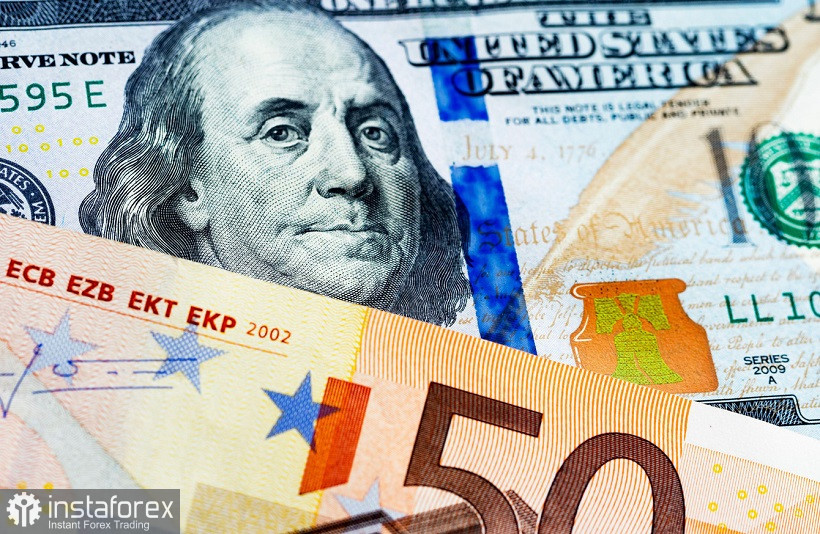The euro-dollar pair yesterday updated another price low, reaching 0.9953. In general, new lows in the foreseeable future will be limited to 20 years ago, since in 2002, the EUR/USD pair traded in the range of 0.85–1.05. Therefore, one and a half thousand points down from the parity level, so to speak, were "staked out" in 2002.
However, at the moment, these circumstances are symbolic. In practical terms, the more pressing question is: can the EUR/USD bears settle below parity, and if so, how far will they go from the 1.0000 mark? Today, we can say that the sellers are cautiously probing the "uncharted" price territory, not risking staying within the 99th figure. And although each new attempt to go below 1.0000 looks more confident than the previous one, it is still risky to open short positions below the parity level.
Figuratively speaking, traders make a circle, "capturing" the area of the 99th figure, and then come back, closing the trading day above the parity zone. We see this circle gradually expanding: at first, sellers reversed a step away from parity, then at 0.9998. Yesterday, the price low was fixed at 0.9953. And yet, it is still premature to announce the development of a downward movement: for this, the bears need at least to gain a foothold below the key support level.

Here it is necessary to highlight an important point: the downward trend for the pair is still in force—the only question is how far sellers can go down from the 1.0000 target. Traders are justifiably afraid of "catching the price bottom," so they act extremely cautiously within the 99th figure. But in general, there are no prerequisites for a large-scale price reversal today and are not expected. The fundamental picture clearly favors the dollar, while the euro is under the yoke of economic and geopolitical problems. Therefore, EUR/USD buyers can now only count on corrective upward waves.
It is noteworthy that EUR/USD buyers actually ignored Bloomberg's information published today that the ECB will present an unlimited bond buying tool next week, which will help markets "adjust to sharper and faster interest rate hikes than previously thought." Despite the hawkish nature of this message, the euro remained under pressure.
Rumors have been circulating on the market for several weeks that the ECB may raise rates by 50 basis points in July. But, firstly, such assumptions are still the subject of discussion, and secondly, even if the members of the European regulator decide to take this step, they will still be behind—at least with respect to the Fed.
The fact is that after the release of data on the growth of the consumer price index in the United States and the producer price index, hawkish expectations regarding the Fed's further actions have significantly increased in the market. Market participants estimate the probability of a 100-point increase following the results of the July meeting at 88%. Such a step would be unprecedented. Therefore, the very fact that this scenario is being discussed in a practical plane allows the dollar to stay afloat and dominate.
Moreover, most economists surveyed by Bloomberg still doubt that the European Central Bank will deviate from the previous plan. In their opinion, the deposit rate, which currently stands at -0.5%, will be increased by 25 basis points in July and 50 points in September. After that, according to general forecasts, at each subsequent meeting, until the March meeting in 2023, the ECB will increase the rate in 25-point increments until it reaches 1.25%.
All this suggests that the dollar in the foreseeable future will retain its attractiveness in tandem with the euro. Here we do not even consider other fundamental factors that support the US currency against increased anti-risk sentiment.
And yet the main question, in my opinion, remains unanswered—to what "depth" are EUR/USD sellers able to descend within the framework of the development of the downward trend?
Indeed, it is necessary to be careful when opening short positions on the pair. On the one hand, corrective pullbacks do not allow you to enter sales with an optimal price gap. On the other hand, the bears of the pair feel insecure under the 1.0000 mark.
It may be necessary to "follow the beaten path" here. For example, yesterday, traders identified themselves at 0.9953, impulsively declining and bouncing back. Therefore, this target is now the main downward target and the support level, which coincides with the lower line of the Bollinger Bands indicator on the D1 timeframe. Therefore, the following targets can be determined on corrective upward pullbacks: 1.0050, 1.0000, 0.9955. Longs in any case look risky, given the prevailing fundamental background and the widespread dominance of the US currency.





















